Click on images to enlarge

infestation (Photo: Land Protection, QDNRW)

habit (Photo: Sheldon Navie)
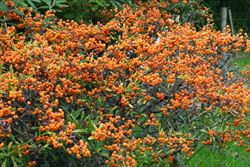
habit in fruit (Photo: Trevor James)
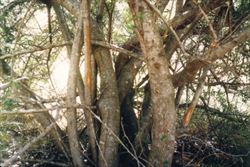
large trunks on older plants (Photo: Land Protection, QDNRW)

older branch with greyish bark and spines (Photo: Sheldon Navie)

younger branch with short side branches ending in spines (Photo: Sheldon Navie)

elongated leaves with entire margins (Photo: Sheldon Navie)
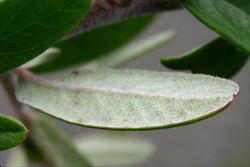
close-up of whitish hairy leaf undersides (Photo: Trevor James)
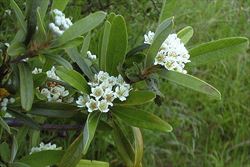
flowers borne in dense clusters (Photo: Jackie Miles and Max Campbell)
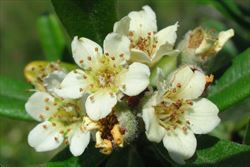
close-up of flowers (Photo: Forest and Kim Starr, USGS)
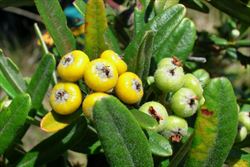
immature fruit (Photo: Forest and Kim Starr, USGS)

close-up of immature fruit covered in hairs (Photo: Forest and Kim Starr, USGS)
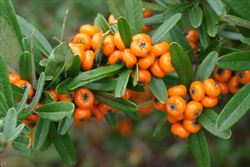
mature fruit (Photo: Trevor James)

close-up of bright orange mature fruit (Photo: Trevor James)
Scientific Name
Pyracantha angustifolia (Franch.) C.K. Schneid.
Synonyms
Cotoneaster angustifolia Franch.
Family
Malaceae (New South Wales)Rosaceae (Queensland, the ACT, Victoria, Tasmania, South Australia and Western Australia)
Common Names
fire thorn, firethorn, narrow leaf firethorn, narrow-leaf firethorn, narrowleaf firethorn, orange fire thorn, orange firethorn, orange thorn, pyracantha, yellow firethorn
Origin
Native to south-western China.
Cultivation
Orange firethorn (Pyracantha angustifolia) has been cultivated as a garden ornamental, particularly in the temperate regions of Australia.
Naturalised Distribution
This species is widely naturalised in south-eastern Australia, but naturalised populations are generally scattered and very localised. It is most common in the tableland regions of New South Wales, in the ACT and in Victoria. Also present in other parts of New south Wales, in the cooler parts of south-eastern Queensland, and in south-eastern South Australia.
Also naturalised overseas in southern Africa, New Zealand, south-western USA (i.e. California) and Hawaii.
Habitat
This species invades open woodlands, forests, urban bushland, waterways and grasslands in temperate and sometimes also sub-tropical regions.
Habit
A large upright (i.e. erect) or arching spiny shrub usually growing 2-4 m tall, occasionally reaching up to 5 m in height, and spreading up to 5 m across.
Distinguishing Features
- a large spiny shrub growing 2-5 m tall and spreading up to 5 m across.
- its stems are densely hairy and grey or whitish when young, turning reddish-brown or darker grey as they mature.
- short side-branches are formed off the main branches which bear most of the elongated entire leaves.
- the upper leaf surfaces are dark green, almost hairless and shiny, while their undersides are densely hairy and whitish.
- its white flowers (8-12 mm across) have five petals and are borne in dense clusters.
- its small berry-like fruit (5-9 mm across) are turn yellow or orange when ripe.
Stems and Leaves
The stems are grey or whitish in colour and densely hairy (i.e. pubescent) when young. Older stems turn reddish-brown or darker grey in colour and develop sharp rigid spines. Short lateral branches are formed off the main branches.
The leaves are alternately arranged along the main branches and clustered at the tips of the short side branches. They are relatively narrow (i.e. elongated) or paddle-shaped (i.e. cuneate) and borne on stalks (i.e. petioles) 1-3 mm long. The leaves (2-7 cm long and 5-13 mm wide) have entire margins that are curved under (i.e. revolute). Their upper surfaces are dark green, shiny and almost hairless (i.e. glabrous), while their undersides are densely hairy and whitish in colour.
Flowers and Fruit
The flowers are borne in dense clusters (i.e. corymbs) on the short side branches, each clusters containing up to 30 flowers. These flowers (8-12 mm across) have five white petals, five small sepals and numerous (20) stamens. Flowering occurs during spring and early summer.
The fruit look like berries or tiny apples (i.e. they are pomes) and turn from green to yellow, orange or orange-red in colour as they mature. These fruit (5-9 mm across) are rounded, but slightly flattened, and covered in small downy hairs (particularly when they are young). Each fruit contains five seeds.
Reproduction and Dispersal
This species reproduces entirely by seed. These seeds are mostly dispersed by birds and other animals (e.g. foxes) that eat the fruit, but may also be spread by water or in dumped garden waste.
Environmental Impact
Orange firethorn (Pyracantha angustifolia) is regarded as an environmental weed in Victoria, the ACT and New South Wales, and as a potential environmental weed or "sleeper weed" in other parts of southern Australia.
Legislation
This species is declared under legislation in the following states and territories:
- ACT: C4 - prohibited pest plant (a pest plant whose propagation and supply is prohibited).
- Western Australia: Prohibited - on the prohibited species list and not permitted entry into the state.
Management
For information on the management of this species see the following resources:
- the Pyracantha or firethorn page on the South Coast Weeds website at http://www.esc.nsw.gov.au/Weeds/index.asp.
Similar Species
Orange firethorn (Pyracantha angustifolia) is very similar to scarlet firethorn (Pyracantha coccinea), broad-leaf firethorn (Pyracantha crenatoserrata), Nepalese firethorn (Pyracantha crenulata) and Roger's firethorn (Pyracantha rogersiana). These species can be distinguished by the following differences:
- orange firethorn (Pyracantha angustifolia) has relatively narrow leaves (5-13 mm wide) with entire margins. These leaves have rounded tips and undersides that are densely covered with white hairs (i.e. tomentose). Its mature fruit are yellow to deep orange in colour and are usually covered in white hairs (i.e. pubescent).
- scarlet firethorn (Pyracantha coccinea) has relatively broad leaves (10-20 mm wide) with finely toothed (i.e. crenulate) margins. These leaves have pointed tips and undersides that are hairless (i.e. glabrous) or slightly hairy (i.e. puberulent). Its mature fruit are bright red or scarlet in colour and are usually hairless (i.e. glabrous).
- broad-leaf firethorn (Pyracantha crenatoserrata) has relatively broad leaves (10-20 mm wide) with almost entire or slightly toothed (i.e. crenulate) margins. These leaves have rounded tips and undersides that are hairless (i.e. glabrous). Its mature fruit are bright red in colour and are usually hairless (i.e. glabrous).
- Nepalese firethorn (Pyracantha crenulata) has relatively narrow leaves (6-10 mm wide) with sharply toothed (i.e. serrate) margins. These leaves have pointed tips and undersides that are hairless (i.e. glabrous). Its fruit are bright red or dark red in colour and are usually hairless (i.e. glabrous).
- Roger's firethorn (Pyracantha rogersiana) has relatively narrow leaves (5-10 mm wide) with bluntly toothed (i.e. crenate) margins. These leaves have rounded tips and undersides that are hairless (i.e. glabrous). Its fruit are yellow to reddish-orange in colour and are usually hairless (i.e. glabrous).
Orange firethorn (Pyracantha angustifolia) is also relatively similar to the cotoneasters (Cotoneaster spp.) and hawthorns (Crataegus spp.). However, the cotoneasters (Cotoneaster spp.) can be distinguished by the lack of spines on their stems, and the hawthorns (Crataegus spp.) can be distinguished by their deeply toothed or lobed leaves.

